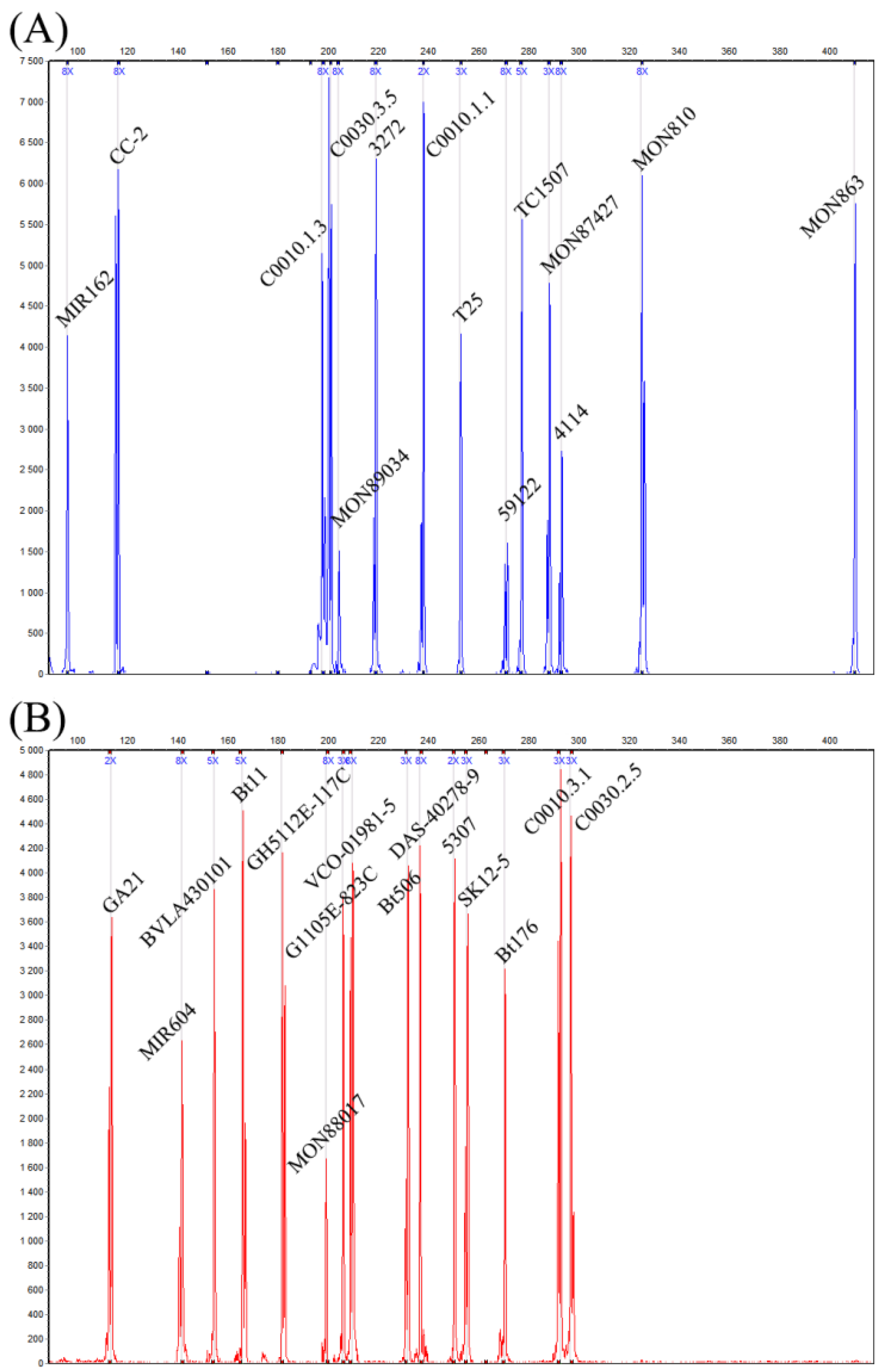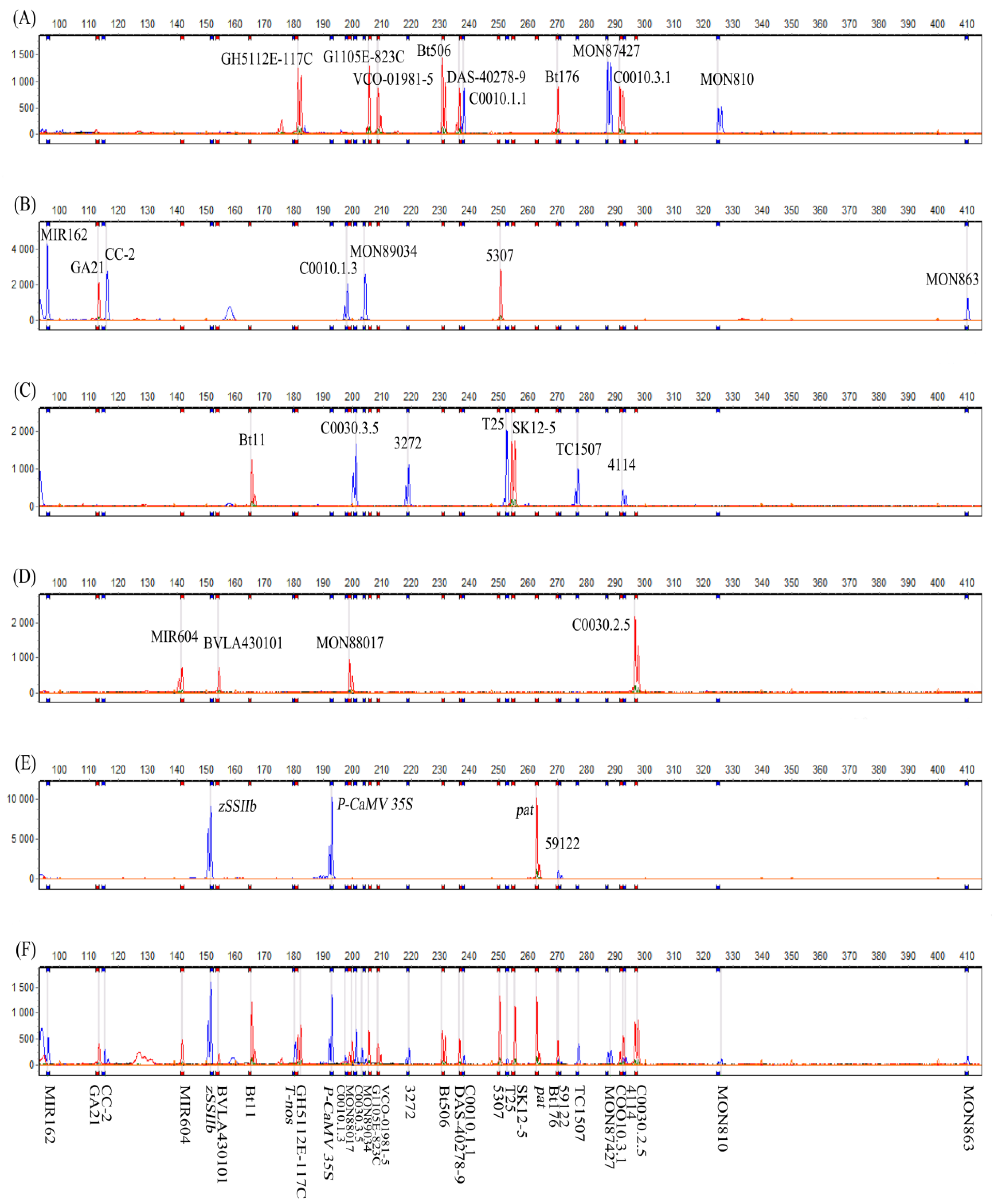A Multiplex PCR System for the Screening of Genetically Modified (GM) Maize and the Detection of 29 GM Maize Events Based on Capillary Electrophoresis
Abstract
:1. Introduction
2. Materials and Methods
2.1. Samples
2.2. DNA Extraction
2.3. Synthesis of Fluorescently Labeled Primers
2.4. PCR System and Procedures
2.5. Capillary Electrophoresis
2.6. Specificity Analysis
2.7. Limit-of-Detection (LOD) and Blind-Sample Analyses
3. Results
3.1. Collection and Molecular Characterization of Gm Maize Events
3.2. Specificity Analysis of Fluorescently Labeled Primers
3.3. Specificity Analysis of the Multiplex System
3.4. LOD Analysis
3.5. Practical Applicability
4. Discussion
Supplementary Materials
Author Contributions
Funding
Institutional Review Board Statement
Informed Consent Statement
Data Availability Statement
Acknowledgments
Conflicts of Interest
References
- International Service for the Acquisition of Agri-Biotech Applications. ISAAA Brief 55-2019: Executive Summary. 2019. Available online: https://www.isaaa.org/resources/publications/briefs/55/executivesummary/default.asp (accessed on 10 January 2022).
- Li, Y.H.; Peng, Y.F.; Hallerman, E.M.; Wu, K.M. Biosafety management and commercial use of genetically modified crops in China. Plant Cell Rep. 2014, 33, 565–573. [Google Scholar] [CrossRef]
- Kamle, M.; Kumar, P.; Patra, J.K.; Bajpai, V.K. Current perspectives on genetically modified crops and detection methods. 3 Biotech 2017, 7, 219. [Google Scholar] [CrossRef]
- Lee, D.G.; Park, J.E.; Kim, M.J.; Kim, H.J.; Kim, H.Y. Detection of GM Canola MS11, DP-073496-4, and MON88302 events using multiplex PCR coupled with capillary electrophoresis. Food Sci. Biotechnol. 2021, 30, 565–570. [Google Scholar] [CrossRef]
- Zeng, H.J.; Wang, J.B.; Jia, J.W.; Wu, G.G.; Yang, Q.W.; Liu, X.F.; Tang, X.M. Development of a lateral flow test strip for simultaneous detection of BT-Cry1Ab, BT-Cry1Ac and CP4 EPSPS proteins in genetically modified crops. Food Chem. 2021, 335, 127627. [Google Scholar] [CrossRef]
- Fortunati, S.; Giannetto, M.; Rozzi, A.; Corradini, R.; Careri, M. PNA-functionalized magnetic microbeads as substrates for enzyme-labelled voltammetric genoassay for DNA sensing applied to identification of GMO in food. Anal. Chim. Acta 2021, 1153, 338297. [Google Scholar] [CrossRef]
- Guenthner, J.F.; Johnson, A.J.; Mclntosh, C.S. Seed variety mix: An indicator for GM potato identity preservation. Am. J. Potato Res. 2012, 89, 172–174. [Google Scholar] [CrossRef]
- Turkec, A.; Lucas, S.J.; Karlik, E. Monitoring the prevalence of genetically modified (GM) soybean in Turkish food and feed products. Food Control 2016, 59, 766–772. [Google Scholar] [CrossRef]
- Fu, W.; Wei, S.; Wang, C.G.; Du, Z.X.; Zhu, P.Y.; Wu, X.Y.; Wu, G.; Zhu, S.F. A temperature-tolerant multiplex elements and genes screening system for genetically modified organisms based on dual priming oligonucleotide primers and capillary electrophoresis. Food Chem. 2017, 229, 396–402. [Google Scholar] [CrossRef] [PubMed]
- Liu, H.; Wang, J.B.; Li, P.; Bai, L.; Jia, J.W.; Pan, A.H.; Long, X.Q.; Cui, W.D.; Tang, X.M. Rapid detection of P-35S and T-nos in genetically modified organisms by recombinase polymerase amplification combined with a lateral flow strip. Food Control 2020, 107, 106775. [Google Scholar] [CrossRef]
- Block, A.; Debode, F.; Grohmann, L.; Hulin, J.; Taverniers, I.; Kluga, L.; Barbau-Piednoir, E.; Broeders, S.; Huber, I.; van den Bulcke, M.; et al. The GMOseek matrix: A decision support tool for optimizing the detection of genetically modified plants. BMC Bioinform. 2013, 14, 256. [Google Scholar] [CrossRef] [Green Version]
- Chen, L.H.; Zhou, J.F.; Li, T.T.; Fang, Z.W.; Li, L.; Huang, G.; Gao, L.F.; Zhu, X.B.; Zhou, X.S.; Xiao, H.F.; et al. GmoDetector: An accurate and efficient GMO identification approach and its applications. Food Res. Int. 2021, 149, 110662. [Google Scholar] [CrossRef] [PubMed]
- Scholtens, I.; Laurensse, E.; Molenaar, B.; Zaaijer, S.; Gaballo, H.; Boleij, P.; Bak, A.; Kok, E. Practical experiences with an extended screening strategy for Genetically Modified Organisms (GMOs) in real-life samples. J. Agric. Food Chem. 2013, 61, 9097–9109. [Google Scholar] [CrossRef] [PubMed]
- Takabatake, R.; Kagiya, Y.; Minegishi, Y.; Yeasmin, S.; Futo, S.; Noguchi, A.; Kondo, K.; Mano, J.; Kitta, K. Development and evaluation of rapid screening detection methods for genetically modified crops using loop-mediated isothermal amplification. Food Chem. 2018, 252, 390–396. [Google Scholar] [CrossRef]
- Wei, S.; Wang, C.G.; Zhu, P.Y.; Zhou, G.B.; Fu, W.; Wu, X.Y. A high-throughput multiplex tandem PCR assay for the screening of genetically modified maize. LWT—Food Sci. Technol. 2018, 87, 169–176. [Google Scholar] [CrossRef]
- Chaouachi, M.; Zellama, M.S.; Nabi, N.; Ben Hafsa, A.; Said, K. Molecular identification of four genetically modified maize (Bt11, Bt176, Mon810 and T25) by duplex quantitative real-time PCR. Food Anal. Methods 2014, 7, 224–233. [Google Scholar] [CrossRef]
- Datukishvili, N.; Kutateladze, T.; Gabriadze, I.; Bitskinashvili, K.; Vishnepolsky, B. New multiplex PCR methods for rapid screening of genetically modified organisms in foods. Front. Microbiol. 2015, 6, 757. [Google Scholar] [CrossRef] [Green Version]
- Singh, M.; Bhoge, R.K.; Randhawa, G. Crop-specific GMO matrix-multiplex PCR: A cost-efficient screening strategy for genetically modified maize and cotton events approved globally. Food Control 2016, 70, 271–280. [Google Scholar] [CrossRef]
- Park, S.B.; Kim, H.Y.; Kim, J.H. Detection of a screening method for the monitoring of 38 genetically modified maize events in food and feed in South Korea. Food Control 2017, 73, 1459–1465. [Google Scholar] [CrossRef]
- Park, J.H.; Seol, M.A.; Eum, S.J.; Kim, I.R.; Lim, H.S.; Lee, J.R.; Choi, W. Development of a multiplex PCR method for identification of four genetically modified maize lines and its application in living modified organism identification. J. Plant Biotechnol. 2020, 47, 309–315. [Google Scholar] [CrossRef]
- Wang, F.J.; Feng, J.L.; Ye, S.D.; Huang, H.N.; Zhang, X.L. Development of a multiplex fluorescence quantitative PCR for detection of genetically modified organisms. Biologia 2018, 73, 21–29. [Google Scholar] [CrossRef]
- Bahrdt, C.; Krech, A.B.; Wurz, A.; Wulff, D. Validation of a newly developed hexaplex real-time PCR assay for screening for presence of GMOs in food, feed and seed. Anal. Bioanal. Chem. 2010, 396, 2103–2112. [Google Scholar] [CrossRef]
- Köppel, R.; Ganeshan, A.; van Velsen, F.; Bucher, T. Five pentaplex real-time PCR systems for the efficient determination of 20 genetically modified maize traits in food. Eur. Food Res. Technol. 2017, 243, 215–225. [Google Scholar] [CrossRef]
- Basak, S.; Ehtesham, N.Z.; Sesikeran, B.; Ghosh, S. Detection and identification of transgenic elements by fluorescent-PCR-based capillary gel electrophoresis in genetically modified cotton and soybean. J. AOAC Int. 2014, 97, 159–165. [Google Scholar] [CrossRef]
- Li, X.F.; Wu, Y.H.; Li, J.; Li, Y.J.; Long, L.K.; Li, F.W. Development and validation of a 48-target analytical method for high-throughput monitoring of genetically modified organisms. Sci. Rep. 2015, 5, 7616. [Google Scholar] [CrossRef] [Green Version]
- Heide, B.R.; Heir, E.; Holck, A. Detection of eight GMO maize events by qualitative, multiplex PCR and fluorescence capillary gel electrophoresis. Eur. Food Res. Technol. 2008, 227, 527–535. [Google Scholar] [CrossRef]
- Jiang, B.; Zhao, Y.K.; Yi, H.M.; Huo, Y.X.; Wu, H.T.; Ren, J.; Ge, J.R.; Zhao, J.R.; Wang, F.G. PIDS: A user-friendly plant DNA fingerprint database management system. Genes 2020, 11, 373. [Google Scholar] [CrossRef] [Green Version]
- International Service for the Acquisition of Agri-Biotech Applications. GM Approval Database. 2021. Available online: https://www.isaaa.org/gmapprovaldatabase/default.asp (accessed on 10 January 2022).
- Dong, W.; Yang, L.T.; Shen, K.L.; Kim, B.; Kleter, G.A.; Marvin, H.J.P.; Guo, R.; Liang, W.Q.; Zhang, D.B. GMDD: A database of GMO detection methods. BMC Bioinform. 2008, 9, 260. [Google Scholar] [CrossRef] [Green Version]
- Ministry of Agriculture and Rural Affairs of the People’s Republic of China. 2022. Available online: http://www.moa.gov.cn/ztzl/zjyqwgz (accessed on 10 January 2022).
- Arumuganathan, K.; Earle, E.D. Nuclear DNA content of some important plant species. Plant Mol. Biol. Report. 1991, 9, 208–218. [Google Scholar] [CrossRef]
- Yun, Z.Y.; Peng, L.P.; Huo, S.N.; Wu, X.; Zhou, J.; Zhang, H.G.; Li, W.J.; Qi, C.; Huang, G.P. Auto-microfluidic thin-film chip for genetically modified maize detection. Food Control 2017, 80, 360–365. [Google Scholar] [CrossRef]
- Fu, W.; Wang, C.G.; Zhu, P.Y.; Xu, W.J.; Li, X.S.; Zhu, S.F. A universal analytical approach for screening and monitoring of authorized and unauthorized GMOs. LWT—Food Sci. Technol. 2020, 125, 109176. [Google Scholar] [CrossRef]
- EFSA Panel Genetically Modified. Technical Note on the quality of DNA sequencing for the molecular characterisation of genetically modified plants. EFSA J. 2018, 16, 5345. [Google Scholar] [CrossRef] [Green Version]
- Liang, C.J.; van Dijk, J.P.; Scholtens, I.M.; Staats, M.; Prins, T.W.; Voorhuijzen, M.M.; da Silva, A.M.; Arisi, A.C.M.; den Dunnen, J.T.; Kok, E.J. Detecting authorized and unauthorized genetically modified organisms containing vip3A by real-time PCR and next-generation sequencing. Anal. Bioanal. Chem. 2014, 406, 2603–2611. [Google Scholar] [CrossRef] [PubMed]
- Niu, C.Q.; Xu, Y.C.; Zhang, C.; Zhu, P.Y.; Huang, K.L.; Luo, Y.B.; Xu, W.T. Ultrasensitive single fluorescence-labeled probe-mediated single universal primer-multiplex-droplet digital polymerase chain reaction for high-throughput genetically modified organism screening. Anal. Chem. 2018, 90, 5586–5593. [Google Scholar] [CrossRef] [PubMed]


| GM Content (% w/w) | PCR Results | ||||||||||||||
|---|---|---|---|---|---|---|---|---|---|---|---|---|---|---|---|
| Bt11 | Bt176 | MON810 | MON863 | TC1507 | |||||||||||
| R1 | R2 | R3 | R1 | R2 | R3 | R1 | R2 | R3 | R1 | R2 | R3 | R1 | R2 | R3 | |
| 1 | + | + | + | + | + | + | + | + | + | + | + | + | + | + | + |
| 0.7 | + | + | + | + | + | + | + | + | + | + | + | + | + | + | + |
| 0.4 | + | + | + | + | + | + | + | + | + | + | + | + | + | + | + |
| 0.1 | + | + | + | + | + | + | + | + | + | + | + | + | + | + | + |
| 0.07 | + | + | + | + | + | − | + | + | + | + | + | + | + | − | − |
| 0.04 | + | + | + | + | + | + | + | + | + | + | + | − | + | + | − |
| 0.01 | + | + | + | + | + | − | + | + | − | + | + | − | + | − | − |
Publisher’s Note: MDPI stays neutral with regard to jurisdictional claims in published maps and institutional affiliations. |
© 2022 by the authors. Licensee MDPI, Basel, Switzerland. This article is an open access article distributed under the terms and conditions of the Creative Commons Attribution (CC BY) license (https://creativecommons.org/licenses/by/4.0/).
Share and Cite
Yi, H.; Liang, Z.; Ge, J.; Zhang, H.; Liu, F.; Ren, X.; Ren, J.; Wang, H.; Ren, J.; Ren, X.; et al. A Multiplex PCR System for the Screening of Genetically Modified (GM) Maize and the Detection of 29 GM Maize Events Based on Capillary Electrophoresis. Agriculture 2022, 12, 413. https://doi.org/10.3390/agriculture12030413
Yi H, Liang Z, Ge J, Zhang H, Liu F, Ren X, Ren J, Wang H, Ren J, Ren X, et al. A Multiplex PCR System for the Screening of Genetically Modified (GM) Maize and the Detection of 29 GM Maize Events Based on Capillary Electrophoresis. Agriculture. 2022; 12(3):413. https://doi.org/10.3390/agriculture12030413
Chicago/Turabian StyleYi, Hongmei, Ziyue Liang, Jianrong Ge, Haibo Zhang, Fengze Liu, Xuezhen Ren, Jie Ren, Haijie Wang, Jiali Ren, Xingxu Ren, and et al. 2022. "A Multiplex PCR System for the Screening of Genetically Modified (GM) Maize and the Detection of 29 GM Maize Events Based on Capillary Electrophoresis" Agriculture 12, no. 3: 413. https://doi.org/10.3390/agriculture12030413





